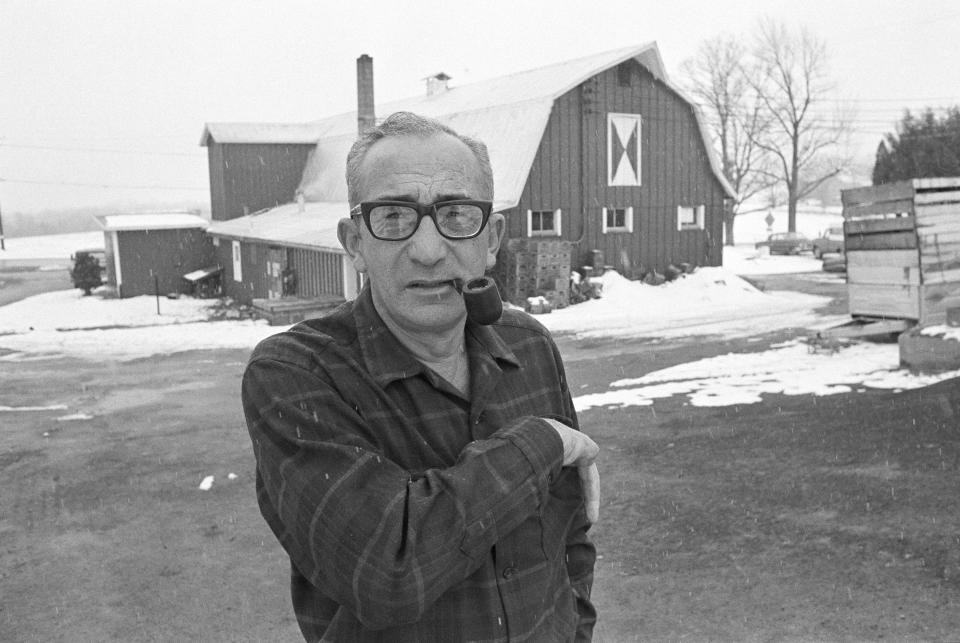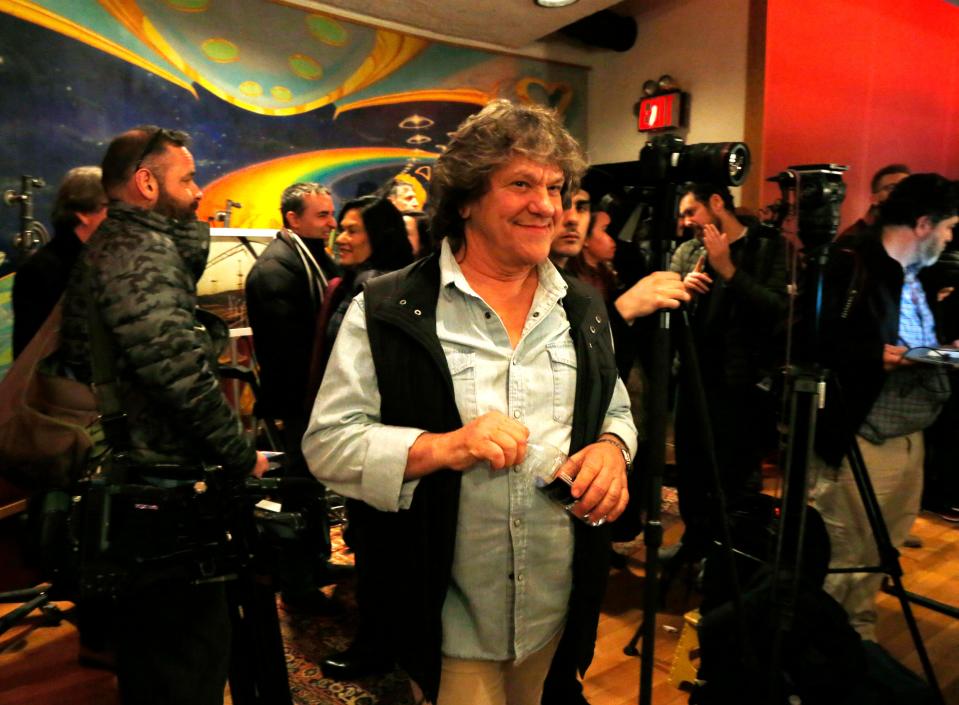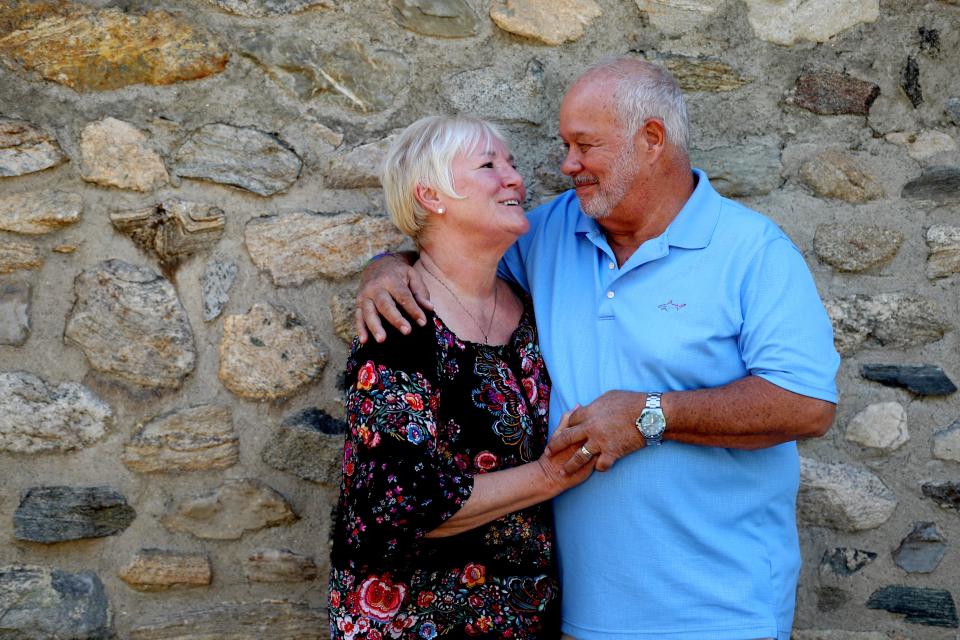Woodstock: How a farmer, four promoters and one couple embody the spirit of the festival
Three concerts, one famous town, 50 years and plenty of controversy.
With just a few words, some people could sum up the five-decade legacy of perhaps the most famous concert ever held – Woodstock.
Others would point to geographical touchstones that for many define this popular culture phenomenon, this American icon, this benchmark for the modern-day music festival, this global brand.
The Woodstock Music and Art Fair was held in August 1969 on an alfalfa field in Bethel, New York, that was owned by dairy farmer Max Yasgur. Woodstock ’94 was held on the Winston Farm in Saugerties, New York, not far from the Town of Woodstock, which provided the inspiration for the 1969 festival. Woodstock ’99 was held at a former U.S. Air Force base in Rome, New York.
Sadly, there will be no Woodstock 50 concert.
But five decades after partners Michael Lang, Artie Kornfeld, Joel Rosenman and John Roberts staged the famous festival, a farmer hosted it on his fields and a couple posed for an iconic photo during the three-day show – Woodstock still stops people in their tracks, turns heads and evokes a we're-all-in-this-together feeling for divided times.
So what does it all mean?
It’s less about logistics, dates and locations and more about an enduring spirit, a generational benchmark, a sweeping movement with resilience and relevance.
Fifty years after hundreds of thousands of young Americans descended on Yasgur’s farm to take a stand against the Vietnam War in particular and authority in general; 50 years after the 1960s counterculture drew a line in the sand; 50 years after Jimi Hendrix's searing rendition of the "Star-Spangled Banner," the word Woodstock continues to demand attention.
And long after the 50th anniversary is celebrated, we will still be talking about Woodstock. And seven people – you may not even know their names – played a role in making that so: Lang and his partners; Yasgur; and a mostly anonymous couple whose embrace was photographed and turned into an album cover that embodied the spirit of the era.
Lang, who has remained the public face of Woodstock across five decades, told the USA TODAY Network shortly before the 49th anniversary of Woodstock that the 1969 festival created “this hope for a better life – a better world, a more compassionate world; and it came at a time when things were very dark.”
He described Woodstock as “sort of a miracle in a way."
"A half-million people got together, nobody followed anybody, everyone came together as a community and a family," he continued. "It was so remarkably different than what the human experience, the day-to-day experience, is like. It was a moment of hope, something that was proof that this was possible – and that resonated.
“They came together from a counterculture that was very involved with trying to make the world a better place. This was a chance for all of us to see if that could happen when we were in charge – and it did.”
As we celebrate Woodstock's 50th anniversary, a look at the societal backdrop against which the 1969 festival was held reveals parallels with today.
The nation was divided then, as it was now. A polarizing president occupied the White House, as one does now. And national conversations revolved around gender and race, just as they do now.
But as the nation once again rallies around Woodstock – the festival, the concept, the lofty ideals contrasting with the day-to-day grind – the American spirit and Woodstock continue to do what they seem to do best, and that is to endure.
Max Yasgur, the farmer who saved Woodstock
The world knows plenty about Woodstock – Bethel, Hendrix, Janis Joplin, the counterculture, 1969, hundreds of thousands and so on.
But even after 50 years, there remains some mystery about Max – Max Yasgur that is, the man on whose farm Woodstock was held.

Yasgur saved Woodstock, as the concert's promoters found his farm in Bethel, Sullivan County, after losing their proposed site in the Town of Wallkill in Orange County.
His willingness to let Woodstock organizers stage the concert on his property, and the acceptance by this older man with glasses, conservative clothing and pipe, of hippies, is as historic as the events that unfolded during that weekend of magical music 50 years ago.
You might say Yasgur validated the entire undertaking – the concert's promoters, the bands that played and those who attended, for the rest of the world.
"I'm a farmer," Yasgur said while addressing the crowd at Woodstock, as captured in the Academy Award-winning documentary about the festival.
"I don't know how to speak to 20 people at one time, let alone a crowd like this. But I think you people have proven something to the world, not only the Town of Bethel or Sullivan County or New York state. You've proven something to the world...The important thing that you've proven to the world is that a half-a-million kids, and I call you kids because I have children who are older than you are, a half a million young people can get together and have three days of fun and music and have nothing but fun and music and I God bless you for it."
Yasgur's appearance on the stage at Woodstock, judging from the crowd's response in the documentary, was as warmly received as Hendrix's version of the "Star-Spangled Banner."
There is so much more to Yasgur than what many know.
According to "The Road to Woodstock," written by Lang, Yasgur:
Was the biggest dairy farmer in Sullivan County in August 1969, owning 2,000 acres that comprised 10 farms, including the 600-acre plot at the intersection of West Shore and Hurd roads in the Town of Bethel, off Route 17B, on which Woodstock was held.
Had only three fingers on his right hand.
Grew up on a farm with a boardinghouse where summer guests stayed.
Became the head of his family's household as a teenager, after his father died.
Studied real estate law at New York University.
Developed delivery routes and built a massive refrigeration complex and pasteurization plant for Yasgur's Dairy, then Sullivan County's largest milk producer.
Had suffered several heart attacks before he had ever heard of Woodstock. An oxygen tank was kept nearby at all times and he had an oxygen tent in his bedroom.
When Lang met Yasgur for the first time, he wrote, "Max had a sharply intelligent face and looked me in the eye."
Elliot Tiber, who wrote "Taking Woodstock," a memoir that featured his family's motel in Bethel and its role in Woodstock, described Yasgur as "a mensch (a good person) and it showed. But he was nobody's fool, either."
Four festival promoters launch a rock concert with a cause
There was mud, there was music and there was so much more at the Woodstock Music and Art Fair.
But just as important were the four partners who staged Woodstock.
Peace and love and hippies and music all fused together. And Lang, Rosenman and Kornfeld, along with Roberts, who died of cancer in 2001, were not only there when it happened, they made it happen.

Woodstock, Kornfeld said, was "all about music and love and about a cause. It was the first rock concert that had a cause...I knew it was special forever."
Asked why he and Roberts agreed to bankroll the plan for Woodstock hatched by Lang and Kornfeld, Rosenman referred to landing acts managed by legendary Woodstock music impresario Albert Grossman, whose roster included Janis Joplin, The Band and Bob Dylan.
"I think we were excited by the thought that we could get local talent in Woodstock, New York and thereabouts, Albert Grossman's talent, to appear at a concert," Rosenman said.
"John Roberts...if you knew him, you'd know he was an adventuresome guy. He and I were in business together in startups. We were building a recording studio in Manhattan. We had just listened to these guys talk to us about a recording studio and possible use of the talent up there in Woodstock ... and some of it was not your local talent, it was world-famous. We thought the four of us could actually do a concert that would be a moneymaker and be exciting and fun. It seemed, we were young, so we didn't want to just be stiff, three-piece business suit-startup guys. We wanted to be hip, swinging startup guys. This was the kind of project that appealed to us and these two guys seemed like they were on that side of the business world, rather than the traditional, Ivy League, conventional types we were seeing for other ventures. The whole thing seemed magical to us."
Lang said a certain innocence surrounded Woodstock.
"We were in the music for the music in those days," he said.
The iconic couple who put the 'love' in 'peace, love and music'
The photo is instantly recognizable: a young woman in big sunglasses clinging to a young man wrapped in a blanket, in a field in the middle of the masses who came to Woodstock in 1969.
The image became a cultural touchstone when it appeared on the cover of the "Woodstock" album.
The two young lovers who stood on that field wrapped in a muddy, colorful quilt are Nick and Bobbi Ercoline of Pine Bush, New York.
“It was all wonderful because we were 20 and in love,” said Bobbi, whose last name at the time was Kelly.
An estimated half a million people showed up for the concert, including 20-year-olds Bobbi and her then-boyfriend Nick Ercoline, who attended for just one day.
Their photo, snapped by Life photographer Burk Uzzle, has become instantly recognizable to many.
Even with the swirling crowd around them, they appear alone in the field, concentrating only on each other.
The couple said they were totally unaware the photo was taken until a friend pointed them out on the album cover in 1970.
Married two years after Woodstock, they have stayed together through thick and thin and in fact according to Nick “are joined at the hip.”
"We've been very fortunate," he said. "We've had a happy life, a regular life, just like most people. But it's been an amazing experience that we feel very fortunate to be a part of."
When Bobbi considers the significance of that one photo – a question the couple has been asked innumerable times over the years – she's quick to respond:
"When I think of Woodstock and I reflect back on those 50 years, I am just very grateful that it was an experience that I've been able to share with the man I've loved for 50 years," she said.
Much has changed since that weekend of love on Yasgur's Farm. The property, now home to the Bethel Woods Center for the Arts, is on the National Register of Historic Places, its famous field is fenced in with weathered gray wood.
The Ercolines have changed, too.

Bobbi became a school nurse; Nick a master carpenter. They are now retired and grandparents.
In August, the Ercolines will celebrate the 50th anniversary at the spot where it all happened: The couple will be part of the celebration marking the milestone, held at Bethel Woods, Aug. 15-18.
"We're very honored to be invited," said Bobbi.
"Just come up and say hello, get a picture and have fun," added Nick.
John W. Barry: [email protected], 845-437-4822, Twitter: @JohnBarryPoJo
Contributing: Dale Ann Deffer
This article originally appeared on Poughkeepsie Journal: Woodstock: 50 years after the farm, the festival and the feeling of a generation
